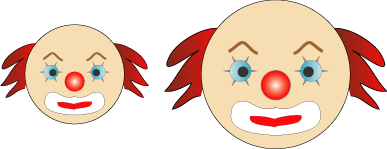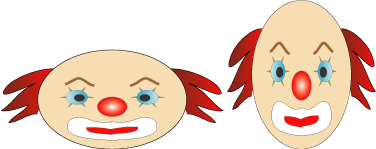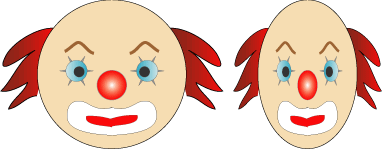Scaling clowns
These five clowns work in pairs. What is the same and what is
different about each pair's faces?
Problem
Here are five clowns' faces:
Image

The clowns are called Andy, Bandy, Candy, Dandy and Eggy. The clowns do their circus acts in pairs.
Sometimes Andy and Candy work together:
Image

What is the same about their faces? What is different?
Sometimes Andy works with Bandy:
Image

What is the same about their faces and what is different?
Sometimes Andy works with Dandy:
Image

What is the same about their faces? What is different?
Sometimes Bandy and Candy work together:
Image

What is the same about their faces and what is different?
Sometimes Bandy works with Dandy:
Image

What is the same about their faces? What is different?
Sometimes Candy works with Dandy:
Image

What is the same about their faces and what is different?
Sometimes Andy works with Eggy:
Image

What is the same about their faces? What is different?
Getting Started
Can you say anything about the size of their faces?
What do you notice about the clowns' eyes?
How about their hair or their noses or their mouths?
What do you notice about the clowns' eyes?
How about their hair or their noses or their mouths?
Student Solutions
Dan and Lewis from Bentley Primary School sent a very detailed solution to this problem. Well done both of you! They said:
First we looked at the five clowns' faces, they were very different! They had cool names. We liked the clowns.We saw that Andy's and Candy's faces were very samey. But Candy's face was bigger, but still looked the same. Like Candy was Andy's bigger brother.
We saw that Andy's head is very nice, but Bandy's head was all squashed and horrible. But his face looked the same. So we think that Bandy's face is a squashed version of Andy's. So maybe Bandy is Andy's squashed brother.
Dandy's head was much taller than Andy's. Andy's head stays the same as his other heads. Andy must be the most popular partner as he goes with everyone.
Bandy's head was wider than Candy's but shorter. When their faces are different sizes, so are their mouths and eyes and noses.
Bandy's head is shorter, Dandy's head taller but thinner.
Candy has the biggest head of all, Dandy's is thinner but the same height as Candy's.
Wow! Andy and Eggy are twins, they must be funny clowns! Thank you for the fun clown challenge!
Thank you both for taking the time to send in your solution, Dan and Lewis. We're glad you enjoyed working on this problem.
Maisie from Crudgington Primary gave us some general advice for answering this question:
1.Look at each clown with its pair carefully
2.Look at the shapes of each clown
3.Look at the sizes of each clown very carefully
4.Look at the shapes of their circular faces
5.Look what kind of circles the clowns faces are
Ryan, also from Crudgington said:
1.The same about Andy's and Candy's face is that they have the
same eye colour and that they have the same coloured mouths,
coloured nose and hair and eyebrow. The only difference is that the
heads are different sizes.
2.The only thing that is the same is that, one head is
stretchy and the other one's not. And the difference is that one
pair of eyes are crossed eyed a little bit and the other pair
aren't. And also the size of the head and width.
3.The difference is with Dandy's is that Dandy's head is far
taller.And Andy's is smaller. The same is that the facial parts are
the same apart from the eyes, which has been cross eyed again a
bit.
4.The right eyebrow of Candy's is a bit slanted. And again
different size heads. The same is that the facial parts and again
the eyes are crossed a bit.
5.Bandy's head is stretched and Candy's head is just big. The
same is the mouths. Everything else is different.
6.Candy's head is bigger and fatter than Dandy's. Dandy's head
is tall. The same is the facial parts.
7.The same is all the facial parts apart from the eyebrows
again.
Emma from Crudgington wrote:
The same about Andy and Candy is that they both have the same
features but all of the features on Candy are bigger than the ones
on Andy.
The same about Andy and Bandy is that they both have the same
features but Bandy's face is wider.
The same about Andy and Dandy is that they have the same
features but Dandy's face is longer than Andy's face.
The same about Bandy and Candy is that they have the same
features but Bandy's face is squished.
The same about Dandy and Candy are that the features are the
same but Candy's face is bigger.
Andy and Eggy are the same.
Matthew from Dedworth also sent in a clear solution:
The features are the same. Andy is smaller than Candy.
The features are the same. Bandy is squashed
horizontally.
The features are the same. Dandy is stretched
vertically.
The features are the same. Bandy is squashed
horizontally.
The features are the same. Dandy is stretched
vertically.
The featurse are the same. Candy is larger, Dandy is squashed
vertically.
The features are the same. There is nothing different.
Matthew from Stanbridge was also very precise:
All the faces have the same features: hair, eyes, eyebrows,
ears, nose and mouth.
Andy (A) and Candy (C): They have the same shape of face, A's
face is smaller than C's.
A and Bandy (B): A's face is round and B's is landscape
oval.
A and Dandy (D): A's face is round and D's is portrait
oval.
B and C: C's face is round and B's is landscape oval.
B and D: B's face is landscape oval and D's is portrait
oval.
C and D: C's face is round and and D's is portrait oval.
A and Eggy (E): their faces are identical.
Well done to you all and especially all the other pupils at Crudgington Primary who sent in solutions: Stephen, Livia, Tom, Dave, Lucy, Lucas, Adam, Mollie, Ellie, Rhiannon and Anna.
Teachers' Resources
Why do this problem?
This problem is designed to get children talking about sameness and difference in the context of size and shape. It is a good chance for them to bring familiar words into the mathematics classroom, and refine them as appropriate.Possible approach
You could start with all the group sitting on the carpet and introduce the problem as it is on the computer. This very simple interactivity is designed to be used by you, rather than individual children, so that two of the clown's faces can be easily compared by putting them into the "boxes".
It is often more difficult to point out things that have not changed and you might need to ask questions to prompt the children. You could ask them to count some features on the clowns' faces, for example. It is likely that children will use comparative words such as larger, bigger, smaller, wider, narrower, higher, shorter ... They might talk about some of the faces looking as if they have
been stretched. Depending on the children's experience, you can encourage them to be as specific as you think appropriate.
After this introduction, the group could work in pairs on the problem so that they are able to talk with a partner. These cards of the clowns' faces can be printed out and possibly laminated, and this black and white sheet of the clowns' faces can be photocopied. This sheet of 16 words related to the problem might also be useful. The children could be
challenged to draw some houses (or anything else you or they might choose!) which are big and small, wide and narrow, low and high, the same and different.
At the end of the lesson the group could show and talk about any pictures they have drawn. You could also use the interactivity again to reinforce any vocabulary the children have learnt and used.
Key questions
Can you say anything about the size of the clowns' faces?
What do you notice about the clowns' eyes?
What can you tell me about their hair/noses/mouths?
Tell me about the pictures you have drawn.
What is the difference between this picture and this picture?
